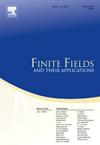Some counterexamples for a version of Springer's theorem on forms of higher degree
IF 1.2
3区 数学
Q1 MATHEMATICS
引用次数: 0
Abstract
Let φ be a form (homogeneous polynomial) of degree d in variables over a field F. We call φ anisotropic over F, if the equality with implies . Otherwise φ is called isotropic. Assume that be a finite field extension, the numbers d and are coprime, and the form φ is anisotropic and diagonal. Does the form φ remain anisotropic over L? This problem can be considered as an analog of the Springer theorem on behaviour of anisotropic quadratic forms under odd degree extensions. In particular, we investigate this problem in the case . We give examples of extensions of degree 2, 3, and 5, which show that in general the answer is negative and pose a few related questions. Cubic extensions are treated in the arithmetic as well as in the general case. Finite fields and their extensions is the principal tool in constructing the counterexamples in question.
关于高次形式的施普林格定理的一些反例
设φ是域F上n≥2个变量的d次形式(齐次多项式),如果等式φ(x1,…,xn)=0且xi∈F意味着x1=…=xn=0,则我们称φ为F上的各向异性。否则φ称为各向同性。设L/F为有限域扩展,数d与[L:F]为同素数,φ为各向异性对角形式。形式φ在L上保持各向异性吗?这个问题可以看作是关于各向异性二次型在奇次扩展下的行为的施普林格定理的类比。特别地,我们研究了F=Q的情况下的这个问题。我们给出了2次、3次和5次扩展的例子,这些例子表明一般情况下答案是否定的,并提出了一些相关的问题。三次扩展在算术和一般情况下都得到处理。有限域Fp及其扩展是构造所讨论的反例的主要工具。
本文章由计算机程序翻译,如有差异,请以英文原文为准。
求助全文
约1分钟内获得全文
求助全文
来源期刊
CiteScore
2.00
自引率
20.00%
发文量
133
审稿时长
6-12 weeks
期刊介绍:
Finite Fields and Their Applications is a peer-reviewed technical journal publishing papers in finite field theory as well as in applications of finite fields. As a result of applications in a wide variety of areas, finite fields are increasingly important in several areas of mathematics, including linear and abstract algebra, number theory and algebraic geometry, as well as in computer science, statistics, information theory, and engineering.
For cohesion, and because so many applications rely on various theoretical properties of finite fields, it is essential that there be a core of high-quality papers on theoretical aspects. In addition, since much of the vitality of the area comes from computational problems, the journal publishes papers on computational aspects of finite fields as well as on algorithms and complexity of finite field-related methods.
The journal also publishes papers in various applications including, but not limited to, algebraic coding theory, cryptology, combinatorial design theory, pseudorandom number generation, and linear recurring sequences. There are other areas of application to be included, but the important point is that finite fields play a nontrivial role in the theory, application, or algorithm.

 求助内容:
求助内容: 应助结果提醒方式:
应助结果提醒方式:


